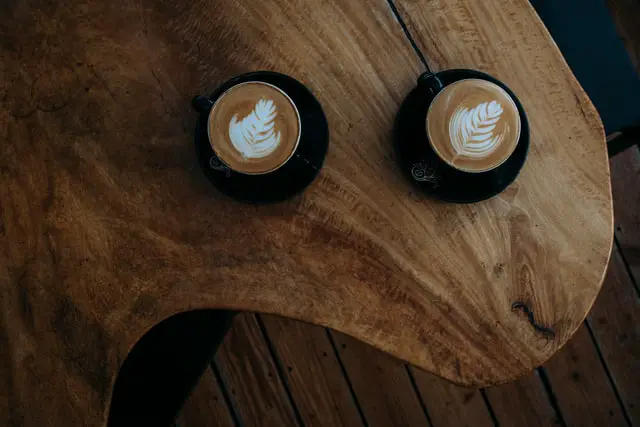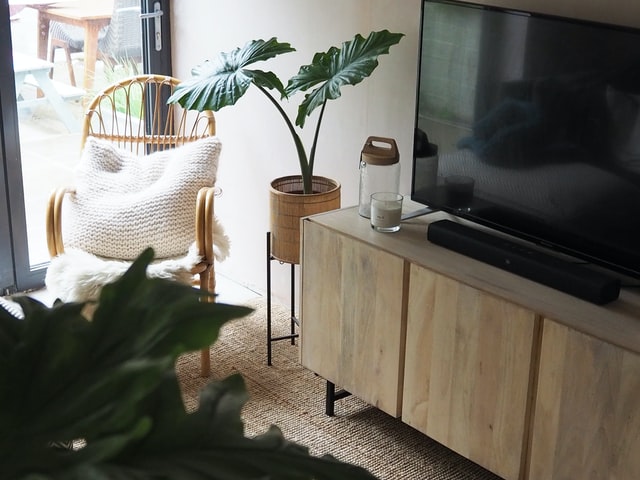Welcome to my article about Mango wood!
If you are purchasing or creating a wood product, the wood you use will make all the difference. It will play an essential role in the look of the product and its durability.
Mango wood is a type of wood to consider integrating into your projects. This article will review its characteristics so you can decide if it’s right for you.
But before we get into the uses, applications and benefits of mango wood, let’s first discuss what mango wood actually is.
Contents
What is Mango Wood?

Also known as Mangifera Indica, mango wood is a hard wood and member of the Anacardiaceae family.
It is native to Southeast Asia, but today, it can also be found in regions of the Pacific and Brazil.
The origin of the tree can be traced back to India going back close to four thousand years. It was brought to East Asia between the 4th and 5th century B.C. Water route trades eventually transported it to other counties.
Today, mango is a national fruit of India, Pakistan and the Philippines. The mango tree is the national tree of Bangladesh.
Mango Wood Properties
Hardness
Woods can be soft or hard. Hardwoods usually come from broadleaved trees while soft wood comes from coniferous tress.
Hardwood trees typically take longer to grow than softwood trees and the wood is generally harder than that yielded from softwoods. However, this is not always the case.
The hardness of a wood is measured on a Janka Scale.
The score is taken after a Janka test is performed which measures the force required to embed an 11.28mm steel ball halfway into a piece of wood. The more force needed, the higher the score will be and the more durable the wood is.
A good Janka scale rating is 1,000 pounds and the industry mean is around 1200 lbs.
Mango has a hardness of 1070 lbs per ft, or 4780 Newtons on the hardness scale.
This puts it’s hardness rating between mahogany and oak woods.
It is moderately durable in standing up to rot and is therefore not recommended for outdoor use unless a protective finish is added.
Water Resistance
While mango wood is more water resistant than some wood species, it will not hold up to large quantities of water and moisture. It will warp and bow overtime.
The wood is also prone to dehydrating and cracking, especially if you live in a cold climate or leave furnishings outside during the winter.
Polishing will serve to keep it moist. It’s also advisable to bring the wood inside during cold weather months.
Workability
Although the wood is durable, it is also soft and pliant. This makes it easy to transform into furnishings and other wood objects.
It works easily with screws, nails, glue and finishing.
While it is usually easy to work with, the interlocked grain can cause tear outs during cutting and machining.
It can also cause shifting and banding on a saw blade during sawing. Its high silica content can cause tools to dull.
Mango Wood Appearance

There are various types of mango wood, but all varieties have lovely interlocking patterns that make them stand out.
They also come in a wide range of colors which run from pink tones to traditional brown. Some variations may even have lovely black streaks.
Note that the color may lighten if exposed to sunlight or it may darken as it ages.
It may also be exposed to a fungus that grows in the heartwood and creates patterns and colors that include yellow, gray and even pink. This is an effect called spalting. And while the fungus may seem worrisome, it only adds to the wood’s aesthetic.
Mango wood is quite lovely but not everyone is a fan. It you are not enjoying the appearance of your mango wood furnishings, you can alter them with a stain or wax.
Uses for Mango Wood
Mango wood can be used for a variety of products. These include the following:
- Flooring
- Small and large furnishings
- Musical instruments
- Plywood
- Veneer
- Doors and window frames
- Kitchen accessories (such as wooden bowls, spoons, etc.)
- Bed frames
- Table boards
- Turned objects
- Paneling
- Curing leather (mango wood is a source of tannins)
How to Clean and Maintain Mango Wood
Here are a few tips that will ensure your mango looks beautiful for years to come:
- Wipe mango wood furniture every day using a soft, slightly moistened cloth. Avoid using course, textured cloths as well as any other cleaning materials with a rough surface. These can scratch the wood.
- A bit of water won’t damage the wood due to the lacquer finish. However, items like alcohol, deodorant, perfume, nail polish and similar liquids can dry it out causing it to become dehydrated. Red wine can stain the wood. If these damaging substances spill onto the wood, it’s recommended to clean it up immediately.
- Place furniture so its not in direct sunlight as this can cause fading.
- Do not place furniture next to radiators or heat sources as this can cause the wood to shift or warp.
- Use placemats and coasters when resting hot drinks or plates on the furniture’s surface.
- If scratches or stains appear, you may cover them with a small amount of paint or varnish in the same color (it’s a good idea to keep your original paint or varnish for this exact purpose if you built the furniture yourself). Test a discreet area to ensure the paint or varnish will go well with the table before applying on the entire surface.
- Rotate furnishings regularly to ensure all sides are equally exposed to light and air.
- Do not use harsh detergents or ammonia-based cleaning products on mango wood. They will strip the moisture and corrode the finish.
- Rub wax into the wood on a regular basis to protect its finish and retain the moisture of the wood.
Sustainability of Mango Wood
Many of today’s consumers look for sustainability in the products they buy. Mango wood checks off all the boxes when it comes to eco-friendliness.
Mango trees produce mango fruit. However, their production slows down over time and once trees are about 15 years old, they completely dry up. Farmers are forced to replace old trees with newer trees.
The trees are usually burned when they can no longer bear fruit. Using the tree’s wood to create furnishings and other products is a great way to ensure they don’t end up getting destroyed in a fire.
The wood is also great because its sustainable, biodegradable and recyclable. If you have a mango wood product that has outlasted its use, you can always recycle the wood to incorporate it into another product.
And if it ends up getting thrown out, it will never harm the atmosphere. It is an all-natural material that is 100% biodegradable.
It’s also worth mentioning that when the trees stop bearing fruit the wood absorbs more nutrients. This helps it attain a rich grain and gorgeous color.
Mango vs. Other Hardwoods
Mango is a great option to use for your wood projects, but there are other hardwoods, like oak and maple, that have similar characteristics and are arguably just as beautiful.
However, oak and maple trees take close to 100 years to reach maturity as compared to mango’s 15 years. This makes mango a more sustainable option.
As compared to maple, mango wood is more pliable. This makes it easier to shape into furnishings and musical instruments.
Mango is often compared to teak because the two woods have a similar appearance. However, mango is a lot more affordable than teak making it a better option for many.
What is Dakota Mango?
Dakota Mango is a popular type of mango wood. It is available in dark stained and light finishes. It has a timeless design and offers a clean contemporary style and a solid design.
The wood is well complemented with square wooden handles although other types of woods and metals will be suitable as well.
Mango Wood Pricing and Availability
Mango is typically moderately priced. It is usually sourced from Hawaii although it can be found in Asia as well.
It is plentiful and can be bought at lower price points than exotic woods like teak, mahogany and cypress.
Benefits of Mango Wood
Mango wood offers many benefits including the following:
- Durable: If cared for properly, mango wood will withstand the test of time.
- Affordable: Mango wood is more affordable than other woods with similar characteristics.
- Sustainable: Mango wood is a biodegradable, all-natural material. Using it for projects saves it from being burned.
- Pliable: The wood’s pliability makes it easy to shape into furnishings and products.
- Attractive: The wood is known for its terrific color and unique grain.
It can also come in handy for medicinal uses. It is used in the creation of remedies and for cooking certain types of food.
It has antibiotic properties, and it can be absorbed by the body without specific processing or preparation.
Mango Wood Hazards
The peel of the mango fruit contains allergenic urushiols which can cause rashes and other skin issues. People who are allergic to other plants in the Anacardiacae family are especially high risk.
If you suspect you may have a reaction, you should avoid using mango wood in remedies and you should not work with the wood as the dust can cause skin irritations.
Mango Wood: Conclusion
There are a variety of woods you can use for your projects, but mango wood stands out for its workability, affordability, durability and terrific looks.
I hope this article has been helpful in enabling you to decide if mango wood is right for your next project.
Here are some other articles you may also enjoy:
MDF vs Plywood
How To Remove Mold From Rough Cut Wood

About The Author: Hi There! I’m Dave. I’m a certified millworker and carpenter, and have been working in the industry for over 10 years. I created this website to pass on my knowledge so that other enthusiasts, no matter what their skill level, can enjoy the craft as much as I do. I hope you enjoy!
